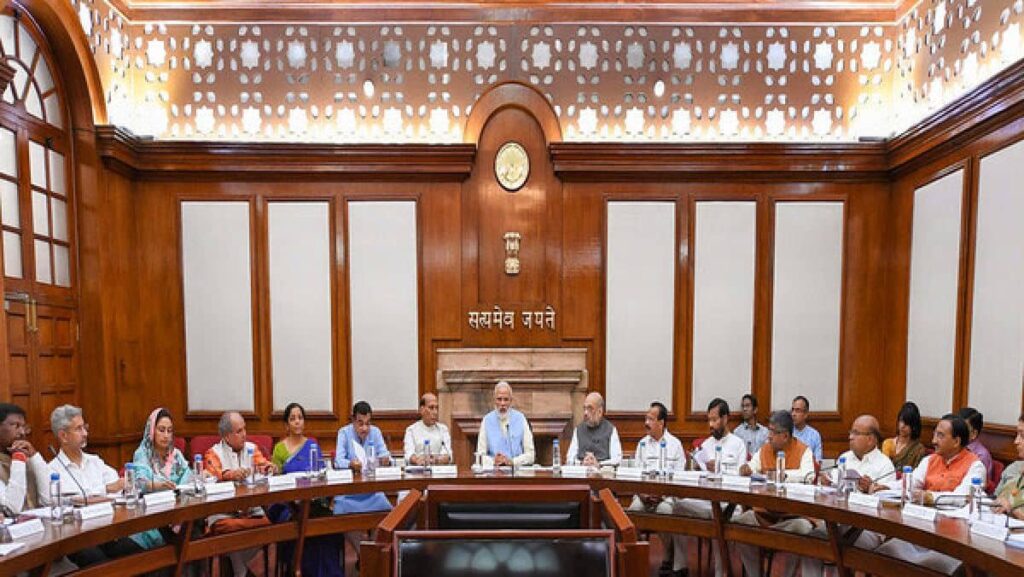Recently, the Modi government witnessed a comprehensive reallocation of the council of ministers. The expansion of the union cabinet includes thirty-six fresh faces, promotion of seven existing ministers and a controversial drop of twelve well-established high profile ministers like Mr. Ravi Shankar Prasad, Mr. Prakash Javedakar and Mr. Harshvardhan. In all, forty three ministers were sworn in, making the overall strength of the council of ministers as seventy seven. This is the first cabinet reshuffle since the prime minister took charge of his position for the second time in 2019.
Source – One India
This reshuffling has been presented as a step towards proclaiming ‘minimum government-maximum governance’ by the ruling party, explaining the rigorous inclusion of many new members and the bold step of taking down some. The government has been a constant target of negative criticism by many, as a result of alleged mishandling of the covid crisis during the second wave. The rearrangement of ministers perhaps is an attempt of correction in the same context.
The PM sought to change faces of those earlier handling important ministries of health, education and labour in this regard. This decision certainly invited controversy and several interpretative explanations by political critiques and the citizens of India.
Source – Business Standard
Interestingly, a significant number of the new ministers are from poll-bound states and those which recently went through assembly elections. Seven legislators are from Uttar Pradesh, ready for poll early next year. This composition has been explained by some critiques as an attempt of the government to win over particular communities like the- non Yadav OBCs, non-Jatav Dalits and Brahmins ahead of the polls.
Now, the new set of ministers and the noteworthy restructuring of the hierarchy may most definitely have ‘politics’ at its heart but the inclusion of several technocrats and former bureaucrats cannot be sidelined. It can either be explained as a necessary calculated step to improve the efficiency of governmental working or an expression of subtle acceptance of mistakes made by the government in its past. Either which ways, the ultimate decision raises an important question of whether this will open the path to improved implementation or accountability as it should.
The cabinet reshuffle also provided the ruling party with an imperative opportunity to win back its support from those who were perhaps unhappy with their decisions in the past and to include those who complained of being ignored. The decision to induct Anupriya Patel, an Apna dal leader is one such alleged move carefully taken to gain support from smaller allies. Some defectors from West Bengal and leaders like Jyotiraditya Scindia, who had previously helped the party topple Congress in Madhya Pradesh, have also been appointed ministries as a token of reward, one may say.
Another important highlight of all changes is the decision to introduce a new ministry of co-operation. The ministry will be headed by home minister – Mr. Amit Shah.
The overall composition of the new set of ministers is quite different than usual trends seen in the past. There are a significant number of ministers from OBC, SC, ST and other minority communities. Women representation is still far from being termed as sufficient but has definitely improved than what it was before. The emphasis on specifically OBC’s, SC/ST communities can be explained as a calculated attempt of appealing to get closer to the desire of consolidating votes from them.
However, Mr. Shastri- former chairman of the national commission of SC and ST denies the claim, explaining the decision in line with BJP’s mantra – “sabka saath sabka vikas” and refusing electoral compulsions as the prime reason.
Source – The wire
The entire process of rearrangement became an important ‘talk of the town’ for netizens, drawing varied reactions and tweets from them. Tweets also included say of various former ministers, current ministers and politicians from other parties. Some tweets to consider-
“Visionary decision by PM @narendramodi Ji to create a Ministry of Co-operation to boost the cooperative movement in India. It will not only boost the economic growth but also empower people at the grassroots,”
-Ravi Shankar Prasad.
“There is a lesson for ministers in these resignations. If things go right, the credit will go to the PM; if things go wrong the minister will be the fall guy. That is the price a minister pays for implicit obedience and unquestioning subservience,”
-former finance and home minister P. Chidambaram.
Efficient functionality and claimed accountability by these new ministers remains a question, the answer to which only time can unfold.
Written by- Surbhi Chopra
Edited by- Yashasvi Kanodia
The post Change of Portfolios and Party Politics appeared first on The Economic Transcript.

